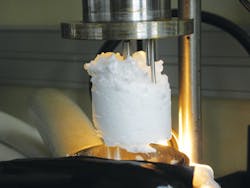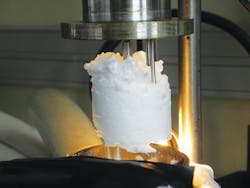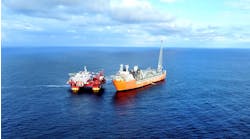Jeremy Beckman
Editor, Europe
Despite budget cuts, deepwater operators continue to support R&D designed to safeguard the integrity of their production systems.IFP Energies nouvelles (IFPEN) is working on new phases of two joint industry projects (JIPs), analyzing the wide-ranging conditions that induce formation of hydrates and waxes, and use of additives to break down resultant plugs.
For these studies IFPEN is performing a wide range of experimental tests at its main research center in Solaize near Lyon, southern France. Here the main test rig is the 140-m (459-ft) long Lyre loop which can operate at temperatures from 0-50°C (32- 122°F) and at pressures up to 100 bar (1,450 psi). Various combinations of instruments can be incorporated to measure variations in fluid flow and composition in different conditions, also to manage flow regimes during each phase from single liquid or gas flow to stratified, slug or annular flow.
Last year IFPEN completed the second phase of a Technip-led JIP assessing how the contractor’selectrical trace heating pipe-in-pipe (ETH-PiP) technology performs in different flow assurance scenarios, in particular during the post-shutdown/re-start process when hydrates have formed.
“The qualification project, sponsored by Total E&P, ExxonMobil Development Co. and Woodside Energy, was executed in two experimental campaigns during 2012-14 and 2014-15,” said Daniel Averbuch, IFPEN’s Subsea Umbilical, Riser and Flowlines program manager. “Hydrate plugs dissociation and associated risks were studied in a 6-in. 18-m [59-ft] long prototype, a replica of the ETH-PiP Total installed for theIslay subsea tieback in the UK northern North Sea, connected to the Lyre loop.
“During tests, massive hydrate plugs weighing up to 200 kg [440 lb] were formed with high water to hydrate conversion rates. The plugs were characterized under differential pressures of up to 35 bar [507 psi]. Several heating dissociation strategies were studied such as dissociation in closed volume, dissociation under unbalanced/longitudinal heating, and dissociation under high differential pressure with and without the presence of oil at the high-pressure side of the plug.”
According to Averbuch, the ETH-PiP technology proved its ability to safely dissociate hydrate plugs in a controlled and safe manner. “Channel creation, avoiding local pressure build-up, was also ensured for all dissociated plugs.
“IFPEN is now putting forward a new hydrate dissociation JIP program. This will investigate the efficiency of conventional remedial techniques such as monoethylene glycol (MEG) injection, depressurization, and nitrogen flushing. The program will also study complementary heating dissociation conditions, mainly at high heating power, with hydrate plugs previously wetted by oil. The plan is to run this project during 2017-18.”
The AHTOL (Additives and Hydrates at Top of Line) JIP is investigating the impact of different types of additives on hydrate plugs in wet gas scenarios, with the Lyre loop undergoing further modifications for the test program. Aims include developing guidelines for use and dosage of the more effective additives and applying the results to real field situations.
Last year, IFPEN conducted three series of tests for AHTOL Phase 2 using MEG, KHI, and anti-agglomerants. “We also performed reference tests for each system,” Averbuch explained, “involving application of water/gas and water/condensate in stratified and annular flow patterns, and further tests in stratified flow where either the additive was sprayed in the gas phase of an unprotected system or unprotected water was sprayed in the gas phase of a protective system. Water/gas systems behave very differently from water/condensate/gas systems. The flow pattern has an important influence on the way the line is plugged when the system is not protected or when the additives are under-dosed.”
Currently IFPEN is developing a sensor in parallel to the AHTOL program to detect hydrate hazards, he added. “The principle is, a local cooling system tells us the margin between the current situation in the pipeline and the temperature that would cause a hydrate plug to form. We have performed several preliminary tests, and we have now proposed testing on a larger scale.”
A further development related to flow assurance involves devising improvements to the long-established Poseidon multiphase pumping technology based on different hydraulics designs. This was originally designed to increase production and extend the use of electric submersible pumps in oil wells with a high gas cut, in which production is limited by the centrifugal pump’s ability to handle gas. Poseidon’s helicon-axial flow stage breaks up large gas bubbles, reducing the volume of gas. The technology is also said to provide more efficient-energy transfer than centrifugal stages and to manage higher percentages of free gas in gassy wells, resulting in higher drawdowns.
“We have an ongoing program to improve the system’s capacity to handle high-viscosity fluids,” Averbuch said, “by applying increased pressure to the pumps, for use in both downhole and subsea pumping applications. This would be more energy-efficient than the current system, leading to increased production at the end of the day.
“Following preliminary testing, we plan to develop additional hydraulics designs which will be validated initially by single-stage testing, and later by testing full-scale prototypes. This development will also involve work on software design for prediction of the pump’s performance.”
Reference
OTC Houston May 2016, “Safe Hydrate Plug Dissociation in Active Heating Flowlines and Risers - Full Scale Test.” C.Tzotzi, T.Parenteau, Forsys Subsea; D.Kaye, Technip; D.Turner, R.Bass, ExxonMobil; J.Morgan, E.Zakarian, Woodside Energy; J.Rolland, M-K.Decrin, Total Exploration-Production.




